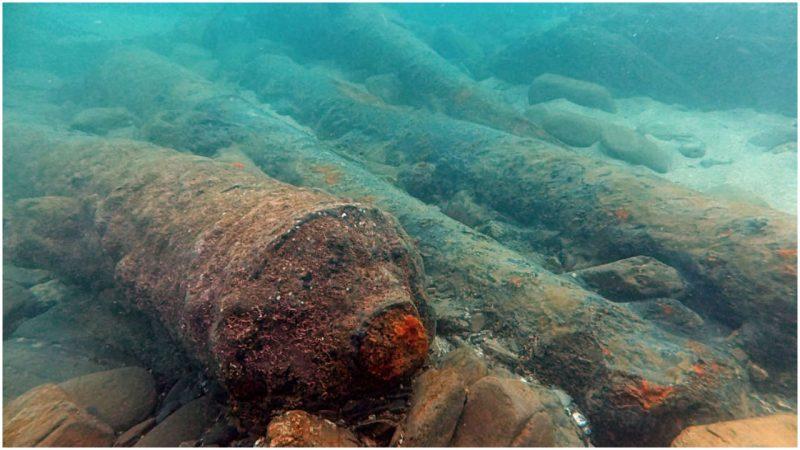Sunken 17th-Century ‘Pirate Ship’ Discovered in Cornwall coast of England

Hand grenades and cannons from the pirate ship’s wreck were found along the Cornwall coast in the United Kingdom from the 17th century.
Divers spotted artifacts from the wreck of the Schiedam, which sank off the coast in 1684 after some storms disturbed the sand that covered the objects on the seafloor.
According to Live Science, the Schiedam, originally a Dutch merchant ship, was taken by Barbary Pirates as a prize in 1683 and was subsequently seized by the Royal Navy and used for transport.
IFL Science reported, “The last of her days were spent as a transport vessel in the English Royal Navy before sinking to the seabed amid a storm on April 4, 1684, while loaded with ammunition from a failed British colony in North Africa.
It’s believed locals looted most of the wreckage, however, evidently, some of its treasures remain.”

The wreck was rediscovered about two years ago
Felce found a similar grenade at the site in May 2017.“I don’t use a metal detector – I use sight,” he explained. “I have become accustomed to what a lot of these things look like.”

The two 17th century hand grenades each consisted of a hollow iron shell filled with gunpowder.Felce told Live Science that he was a frequent visitor to the beach, which is exposed to strong waves from the Atlantic.
Both objects were heavily encrusted after lying on the seafloor for more than 300 years, and “Felce said he at first thought the latest grenade was an ordinary rock until he slipped and dropped it, and it broke open, revealing the two halves of the metal weapon and the explosive powder inside.”
Although the gunpowder in the grenade was damp and centuries’ old, he reported the find to the local police, who called in bomb-disposal experts from the Army to ensure that it was safe to handle.
The Schiedam was first discovered in 1971 by divers near the coast of Cornwall at a depth of 13 to 22 feet. Previous dives revealed an arsenal of weapons in the wreck, including numerous iron canons and carriage wheels.
A magnetometer survey in 1985 suggests that as many as 15 iron cannons may be buried under the sand.

David Gibbons of Cornwall Maritime Archaeology recently snapped a series of 3D photogrammetry images of the rediscovered wreckage.“The Schiedam is a fascinating wreck because it was carrying goods back in 1684 from the English colony of Tangier [Morocco], which had been abandoned to the Moors,” Gibbons told Cornwall Live.
“It represents a pivotal moment in history because the failure of Tangier led the English to look to Bombay instead.”Gibson continued: “Had the English succeeded in carving out a commercial enclave in North Africa and focusing their interests in the Mediterranean instead of in India, then the world would have been a very different place today.”
When the ship ran aground, there were no fatalities, which was unusual.“Because it was a government-owned ship by this time, they wanted to get as much of the cargo off, because it was ordnance,” Felce said in an interview.
“They had to draw on companies [of soldiers] from [the neighboring county of] Devon. These people salvaged as much as they could.”

